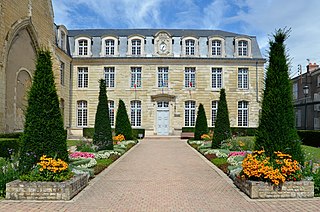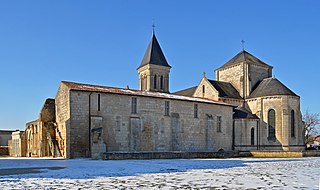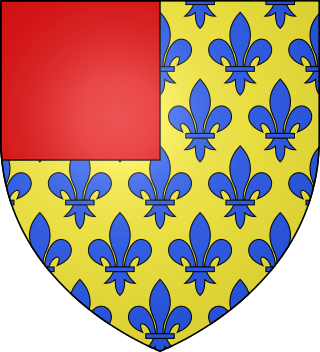
Aimery of Lusignan, erroneously referred to as Amalric or Amaury in earlier scholarship, was the first King of Cyprus, reigning from 1196 to his death. He also reigned as the King of Jerusalem from his marriage to Isabella I in 1197 to his death. He was a younger son of Hugh VIII of Lusignan, a nobleman in Poitou. After participating in a rebellion against Henry II of England in 1168, he went to the Holy Land and settled in the Kingdom of Jerusalem.

The House of Lusignan was a royal house of French origin, which at various times ruled several principalities in Europe and the Levant, including the kingdoms of Jerusalem, Cyprus, and Armenia, from the 12th through the 15th centuries during the Middle Ages. It also had great influence in England and France.
Hugh VI, called the Devilish, was the Lord of Lusignan and Count of La Marche, the son and successor of Hugh V of Lusignan and Almodis de la Marche.
Hugh VII the Brown of Lusignan or Hugues II de La Marche (1065–1151), Sire de Lusignan, Couhé and Château-Larcher and Count of La Marche, was the son of Hugh VI of Lusignan. He was one of the many notable Crusaders in the Lusignan family. In 1147 he took the Cross and followed King Louis VII of France on the Second Crusade.

Hugh X de Lusignan, Hugh V of La Marche or Hugh I of Angoulême was Seigneur de Lusignan and Count of La Marche in November 1219 and was Count of Angoulême by marriage. He was the son of Hugh IX.

Thouars is a commune in the Deux-Sèvres department in western France. On 1 January 2019, the former communes Mauzé-Thouarsais, Missé and Sainte-Radegonde were merged into Thouars.

Aénor of Châtellerault, Duchess of Aquitaine, was the mother of Eleanor of Aquitaine, who became one of the most powerful women of her generation in Europe.
Hugh V, called the Fair or the Pious, was the fifth Lord of Lusignan and Lord of Couhé. He succeeded his father, Hugh IV, sometime around 1026.

Hugh VIII the Old of Lusignan or was the Seigneur de Lusignan, Couhé, and Château-Larcher on his father's death in 1151. He went on crusade, was captured at battle of Harim, and died in captivity.
Bernard William, sometimes Bernard I, was the Duke of Gascony and Count of Bordeaux from c.997 to his death. During his time, Gascony was effectively independent, its duke a sovereign and any connection to the Kingdom of France theoretical. His reign fell during a period of relative peace and prosperity: the Peace of God movement had originated in Gascony in his father's time, monastic reform was introduced during his reign and the period of Viking attacks was over. Nonetheless, it was also a period of increasing feudal fragmentation, and Bernard died a violent death.
William des Roches was a French knight and crusader who acted as Seneschal of Anjou, of Maine and of Touraine. After serving the Angevin kings of England, in 1202 he changed his loyalty to King Philip II of France and became a leading member of his government.

The Château de Montignac is a ruined castle in the commune of Montignac-Charente, in the Charente département of France. The castle is the property of the commune and has been listed since 1962 as a monument historique by the French Ministry of Culture.

Yolande of Brittany, also known as Yolande de Dreux, was the ruler of the counties of Penthièvre and Porhoet in the Duchy of Brittany. Yolande had been betrothed to King Henry III of England in 1226 at the age of seven years, but married Hugh XI of Lusignan, the half-brother of Henry III. Through Hugh, she became Countess of La Marche and of Angoulême. She was the mother of seven children. From 1250 to 1256, she acted as Regent of La Marche and Angoulême for her son, Hugh XII of Lusignan.
William Taillefer, numbered William II or William IV, was the Count of Angoulême from 987. He was the son of Count Arnald II Manzer and grandson of Count William Taillefer I. He stood at the head of the family which controlled not only the Angoumois, but also the Agenais and part of Saintonge. By the time of his death he was "the leading magnate in [the west] of Aquitaine[, but his] eminence ... proved temporary and illusory," evaporating on his death in succession squabbles, revolts and the predations of his erstwhile allies. The principal sources for William's career are Ademar of Chabannes and the anonymous Historia pontificum et comitum Engolismensium.

Aimery I de Châtellerault, was the Viscount of Châtellerault and father of Aenor de Châtellerault. Through his daughter he was the grandfather of Eleanor of Aquitaine, successively queen of France and England.

Aimery IV viscount of Thouars was a companion of William the Conqueror on his Invasion of England in 1066.
Geoffrey II of Thouars, was the son of Savary III. He was the viscount of Thouars from 1015 to 1043.

Geoffrey of Lusignan was the Lord of Vouvant and Soubise, and Count of Jaffa and Ascalon. He was also Lord of Mervent and Moncontour by his wife's rights.

The Conventum is a Latin text from around 1030 that narrates the relations between Duke William V of Aquitaine and Lord Hugh IV of Lusignan in the preceding twenty years. The exact nature of the text is a matter of scholarly disagreement. It has been seen as a record of a legal settlement and as a sui generis literary text presaging the chanson de geste. It concerns Hugh's disputes over land and castles with various other barons of Aquitaine and William's failure to help him. The text is written from Hugh's point of view.